Stephanie A. Mann's Blog, page 277
April 15, 2013
The New Archbishop of Canterbury: Justin Welby
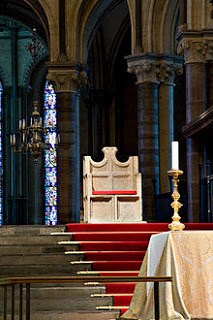 With all the shock and surprise of Benedict XVI's renunciation of the Papacy and Pope Francis' election to the Papacy, I have quite overlooked the installation of the new Archbishop of Canterbury, Justin Welby. The American Spectator describes his background in this article and touches on some surprising facts:
With all the shock and surprise of Benedict XVI's renunciation of the Papacy and Pope Francis' election to the Papacy, I have quite overlooked the installation of the new Archbishop of Canterbury, Justin Welby. The American Spectator describes his background in this article and touches on some surprising facts:This is why Archbishop Welby looks so interesting: He is an authentic Anglican evangelical, homegrown from the 21st century’s most successful outreach movement, known as HTB-Alpha. It began 30 years ago at Holy Trinity Brompton (HTB) in West London, the mega-church that welcomed Welby at a dark time in his life, when he and his wife were devastated by the loss of their first born child, 7-month-old Johanna, killed in a Paris car accident.
“It is in our pain and in our brokenness that we come the closest to Christ,” said Martin Luther. His words have a resonance with Archbishop Welby’s spiritual journey. At the time of his daughter’s death, he was a rising star in the oil industry, finance director and treasurer of the FTSE 100 company Enterprise Oil. He loved the buzz of acquisitions and mergers. But as he nursed his wounds in bereavement, Welby heard God’s call. A talk at HTB by one of the leaders of the U.S. Vineyard Churches, John McClure, inspired him to seek training for ordination. This was not an easy path, for his local bishop rejected Welby as a candidate, saying he had “no future in the Church of England.” But the influential vicar of HTB, the Rev. Sandy Millar, persuaded his parishioner to keep knocking on the door of the ordained ministry, and eventually Welby was accepted for training at St. John’s College, Durham. . . .
ARCHBISHOP WELBY is proud of his HTB roots, but he should not be simplistically pigeonholed. He has a Catholic spiritual director. He spent some years working in Nigeria, which has given him an understanding of the African provinces in the Anglican Communion. They are ultra-conservative in comparison to many liberal American and English churches, and Welby will need to work hard to prevent quarrels and schisms within his international flock. Fortunately he seems well-equipped for this and for the even greater challenges that lie ahead of him.
He also has a background in business, having had a secular career before becoming an Anglican minister and bishop. Justin Welby certainly does face a great many challenges trying to hold the Anglican Communion and the Church of England together. It is interesting to note that the Archbishop of Canterbury is "enthroned":
First, the Archbishop will be installed on the Diocesan throne as the Bishop of the see of Canterbury, the oldest diocese in the English church. He will then be installed on the chair of St Augustine as Primate of All England – the ‘first bishop’ in the country. This latter enthronement has also come to respresent the Archbishop's inauguration as the spiritual leader of the worldwide Anglican Communion.
And, according to that same page, it's interesting to note the date chosen for Justin Welby's enthronement:
The date of the ceremony resonates in several ways: March 21st is the day when the church remembers the martyrdom of Thomas Cranmer, Archbishop of Canterbury, in 1556. It is also the feast day of St. Benedict of Monte Cassino, a significant figure for both Canterbury Cathedral and Archbishop Justin himself, who is an oblate of the Order of Benedict.
Pope Francis sent him a message and the Archbishop commented on Pope Francis' installation as Pope.
Published on April 15, 2013 22:30
April 14, 2013
"The Most Controversial" Robert Persons, SJ
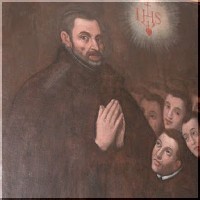 In 2010, Father Thomas McCoog, SJ, published this article in the online journal of the British Jesuits,
Thinking Faith
:
In 2010, Father Thomas McCoog, SJ, published this article in the online journal of the British Jesuits,
Thinking Faith
:On 15 April 2010, the 400th anniversary of the death of Robert Persons, arguably the most controversial Englishman to enter the Society of Jesus, passed without much fanfare. On Thinking Faith, Joe Egerton did indeed pay homage to Persons as he applied principles from the Jesuit’s writings to contemporary political situations, and also drew attention to a persistent preference for Edmund Campion over Persons, his religious superior on the English mission.
For the Elizabethan government, for some Catholic contemporaries and for a few subsequent historians, Persons exemplified the Jesuit of myth and legend. A secular priest, William Watson, himself executed in 1603 for alleged involvement in a plot against King James I, lamented the establishment of an uncommon ecclesiastical structure, the archpresbyterate. The archpriest exercised jurisdiction over the diocesan clergy within England, but according to the regulations, on matters of importance he could not act without prior consultation of the Jesuit superior. Watson complained: ‘For whereas now all Catholikes must depend upon the Archpriest, & the Archpriest upon father Garnet, & Garnet upon Persons, & Persons upon the devel, (the author of all rebellious conspiracies, treasons, murthers, disobedience, heresies, & all such other diabolicall & bloudy designements, as this wicked Iesuit hath hitherto devised) then and in what case this dependency had bin utterly void.’ (A Decacordon of Ten Quodlibeticall Questions concerning Religion and State [N.p. (London), 1602] pp. 150-51).
McCoog describes Persons' mission to England with St. Edmund Campion and points out some interesting contrasts:
Persons was the driving force behind the English mission from its inauguration in 1580 to his death in 1610. For 30 years, he courted earthly powers, wrote masterpieces of controversial literature, adapted Ignatian spirituality for English Catholic (and Protestant) readers, solicited funds for colleges and seminarians, and infiltrated Elizabeth’s court. One may well ask if Campion would have been up to the task if he had survived and Persons been martyred.
Practically from his admission into the Society of Jesus in Rome, Robert Persons retained contact with other Englishmen and campaigned for Jesuit involvement on the English mission. Campion, meanwhile, showed little if any concern for his native land. Indeed, his friend Gregory Martin accused him of forgetting England altogether once he had entered the Society. Collaborating with William, later Cardinal, Allen, Persons finally succeeded in persuading a reluctant Father General Everard Mercurian to seize the opportunity provided by the qualified religious tolerance that would follow the marriage/alliance of Queen Elizabeth and Francis de Valois, Duke of Anjou. Persons volunteered for the mission; Campion was selected. Campion admitted more than once that only obedience motivated him.
And the rest of the article continues to illuminate Father Persons' efforts to support the Jesuit mission to England. Fascinating.
Published on April 14, 2013 22:09
April 13, 2013
"Be Not Afraid" by Blessed John Henry Newman
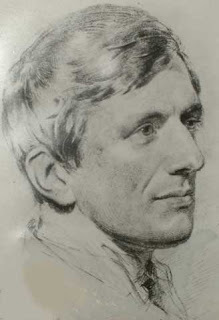 This was yesterday's meditation in the Magnificat prayer magazine, from Blessed John Henry Newman's sermon on "Christian Manhood":
This was yesterday's meditation in the Magnificat prayer magazine, from Blessed John Henry Newman's sermon on "Christian Manhood":Doubt not, then, His power to bring you through any difficulties, who gives you the command to encounter them. He has showed you the way; He gave up the home of His mother Mary to "be about His Father's business," and now He but bids you take up after Him the cross which He bore for you, and "fill up what is wanting of His afflictions in your flesh." Be not afraid,—it is but a pang now and then, and a struggle; a covenant with your eyes, and a fasting in the wilderness, some calm habitual watchfulness, and the hearty effort to obey, and all will be well. Be not afraid. He is most gracious, and will bring you on by little and little. He does not show you whither He is leading you; you might be frightened did you see the whole prospect at once. Sufficient for the day is its own evil. Follow His plan; look not on anxiously; look down at your present footing "lest it be turned out of the way," but speculate not about the future. I can well believe that you have hopes now, which you cannot give up, and even which support you in your present course. Be it so; whether they will be fulfilled, or not, is in His hand. He may be pleased to grant the desires of your heart; if so, thank Him for His mercy; only be sure, that all will be for your highest good, and "as thy days, so shall thy strength be. There is none like unto the God of Jeshurun, who rideth upon the heaven in thy help, and in His excellency on the sky. The Eternal God is thy refuge, and underneath are the everlasting arms." [Deut. xxxiii. 25-27.] He knows no variableness, neither shadow of turning; and when we outgrow our childhood, we but approach, however feebly, to His likeness, who has no youth nor age, who has no passions, no hopes, nor fears, but who loves truth, purity, and mercy, and who is supremely blessed, because He is supremely holy.
Published on April 13, 2013 23:00
A New Historical Novel: Treason: A Catholic Novel of Elizabethan England
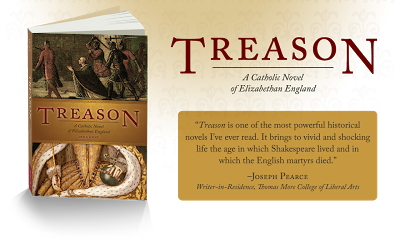
An acquaintance, Rich Leonardi, who reviewed Supremacy and Survival: How Catholics Endured the English Reformation when it first came out, contacted me about this new novel, just released last month by Sophia Institute Press: Treason: A Catholic Novel of Elizabethan England. As Sophia describes the plot of this historical novel:
As Stephen Long steps ashore in England one gray dawn in May 1581, he wonders how many more Catholics will have to die to make Queen Elizabeth feel secure. Involuntarily, he trembles at the thought that soon he may be numbered among them.
For in the days ahead, each time Stephen hears confession or celebrates Mass, he commits yet another act of high treason against the British Crown, for which Queen Elizabeth’s swift penalty is gruesome torture and painful death. As Stephen hastens to find shelter away from that open beach, he struggles not only with fear but with doubt, as well: “Is my mission foolish? Am I nothing more than fresh meat for the queen’s butchers?”
In the light of that same gray dawn, just a few miles north, a heartbroken Caroline Wingate lies awake in her unhappy marriage bed, wrestling with thoughts of a different—perhaps crueler—martyrdom.
Although from her earliest years Caroline has known herself to be called to cloistered contemplative life as a nun, some years ago she was forced by her father into a politically “safe” marriage with an upright Protestant, from whom she must hide her Catholicism—and her true vocation—lest she, too, be executed for her faith.
Hanging by the neck is swift martyrdom, but Caroline’s doubts and guilt have pained her daily for years now. An exile in her own soul, in her lonely desolation she confesses, “I don’t love my husband as I should. For safety’s sake, I cannot give myself wholly to him and must deceive him daily. Nor can I give myself to the One I truly love.”
In a few days, circumstances will force Caroline and the young priest together. With death hastening toward both of them, the beautiful fates of these two faithful Catholics confirm what we today too often forget: our faith is the most powerful force in the world—more powerful than politics, wars, or empires. More powerful even than the hard, cold will of Queen Elizabeth.
In this gripping, heartrending tale, Caroline and Stephen show us that it’s not power that writes the true history of the world; it’s faith: faith and the love that faith alone can awaken and sustain.
I have written to the publisher to see if I may obtain a review copy. Watch this blog space for some follow up!
Published on April 13, 2013 22:30
April 11, 2013
Local History: Servant of God Emil Kapaun and the Medal of Honor
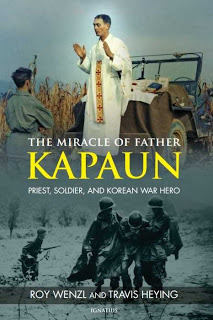 I attended Kapaun-Mount Carmel High School (our school mascot is the Crusader!), the east side co-educational school here in Wichita, Kansas. Before its founding in 1971, there had been two high schools: Chaplain Kapaun Memorial High School, a Jesuit preparatory school for young men established in 1956 and Mount Carmel Academy, a preparatory school for young women established in 1886 under the guidance of the Sisters of Charity of the Blessed Virgin Mary. Everyday in the rotunda of the high school, which was the building the Sisters of Charity had built on east Central, I passed by the display honoring Chaplain Emil Kapaun and the mosaic of Our Lady of Kansas.
I attended Kapaun-Mount Carmel High School (our school mascot is the Crusader!), the east side co-educational school here in Wichita, Kansas. Before its founding in 1971, there had been two high schools: Chaplain Kapaun Memorial High School, a Jesuit preparatory school for young men established in 1956 and Mount Carmel Academy, a preparatory school for young women established in 1886 under the guidance of the Sisters of Charity of the Blessed Virgin Mary. Everyday in the rotunda of the high school, which was the building the Sisters of Charity had built on east Central, I passed by the display honoring Chaplain Emil Kapaun and the mosaic of Our Lady of Kansas.Father Kapaun's cause for sainthood is being sponsored by the Diocese of Wichita and the website is here. Yesterday, April 11, Father Emil Kapaun was posthumously awarded the Medal of Honor. Our local newspaper, The Wichita Eagle, has been very involved in the Father Kapaun story, producing a series of articles, a television special, and even a new book, all about Father Kapaun. This site consolidates the material from the series and reports about the Medal of Honor ceremony.
It's fascinating to be witnessing this process of honoring the namesake of my high school alma mater. I remember reading comments that Servant of God Kapaun should be canonized as a martyr--many of those who saw him taken by the Chinese to their "hospital", which was really a death house, believed he was being punished for his Christian witness in the POW camp. Because there are no witnesses to his death, however, the cause being pursued is for his beatification and canonization as a confessor.
Lord Jesus, in the midst of the folly of war,
your servant, Chaplain Emil Kapaun spent himself
in total service to you on the battlefields and
in the prison camps of Korea, until his
death at the hands of his captors.
We now ask you, Lord Jesus, if it be your will,
to make known to all the world the holiness
of Chaplain Kapaun and the glory of his
complete sacrifice for you by signs of
miracles and peace.
In your name, Lord, we ask, for you are the
source of peace, the strength of our
service to others, and our final hope.
Amen.
Published on April 11, 2013 22:30
April 10, 2013
Travel Highlight: St. Elizabeth of Hungary
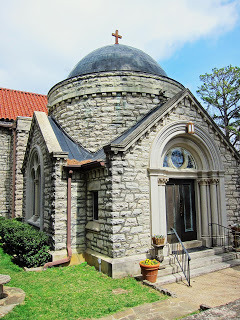 My husband and I travelled to the Ozarks to celebrate our 22nd wedding anniversary last weekend. We stayed at the Big Cedar Lodge outside Branson, and left that sanctuary of rest and relaxation to drive to Eureka Springs, Arkansas. There we visited the Crescent Hotel and then crossed the street to this fascinating church, St. Elizabeth of Hungary. The parish church was originally built as a memorial chapel and then expanded, with two architectural styles combined. The memorial chapel is byzantine, while the nave and sanctuary are romanesque-gothic.
My husband and I travelled to the Ozarks to celebrate our 22nd wedding anniversary last weekend. We stayed at the Big Cedar Lodge outside Branson, and left that sanctuary of rest and relaxation to drive to Eureka Springs, Arkansas. There we visited the Crescent Hotel and then crossed the street to this fascinating church, St. Elizabeth of Hungary. The parish church was originally built as a memorial chapel and then expanded, with two architectural styles combined. The memorial chapel is byzantine, while the nave and sanctuary are romanesque-gothic.The church is unique because you enter through the bell tower and descend to the church.
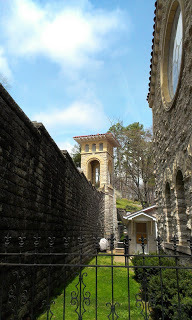
The interior of the original chapel is dominated by a great crystal chandelier, a late 20th century gift.
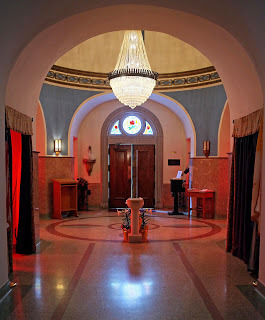
And here is a view of the nave and sanctuary--there is a balcony (you can see the rails to the left and right) with additional seating so that the church has room for 200 worshippers.
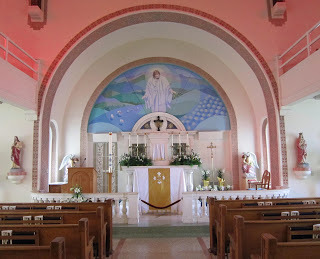
The statuary in the church came from the former parish church dedicated to the Sacred Heart and a hospital, Hotel Dieu, while the benefactor, Richard Kerens (who had built the original chapel in memory of his mother) imported many fine furnishings, according to the parish website:
The existing chapel became the vestibule of the church, with all the exterior construction material of dolomite limestone supplied by local quarries. Kerens imported marble altars and mosaic flooring from Italy. Paintings depicting the Stations of the Cross were donated by the parishioners. Four pieces of statuary taken from the Sacred Heart Church and Hotel Dieu – statues of Our Lady of Perpetual Help, the Sacred Heart of Jesus, and two kneeling angels – were moved to the new Church. These fine pieces of turn-of-the-century statuary still have their home in the interior of the church today.
Here's a picture, taken with my cellphone camera (my husband took the other pictures either with his Canon or Fuji) of one of the Stations of the Cross, which are sometimes combined with the Sorrows of the Blessed Virgin Mary:

Here's some more detail about the church, addressing its architectural uniqueness. Catholics are a minority in Arkansas (only 6% of the population) so a beautiful church like this, with such care and devotion on display throughout its small footprint--the grounds contain additional statuary and a lovely view of the residential area surrounding the church--is really a blessing.
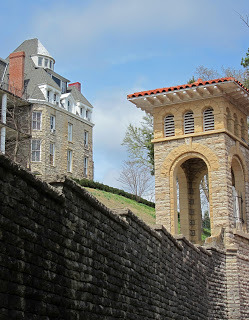 You can see the Crescent Hotel to the left in the photo above. St. Elizabeth of Hungary, pray for us!
You can see the Crescent Hotel to the left in the photo above. St. Elizabeth of Hungary, pray for us!
Published on April 10, 2013 22:30
April 9, 2013
Book Review: The Mirrored World by Debra Dean
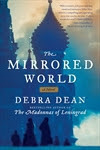
What is it like to see someone you know become a saint--a holy fool for Christ? How does that transformation influence you? Debra Dean tells that story in her new historical novel, The Mirrored World. According to the publisher:
The bestselling author of The Madonnas of Leningrad returns with a breathtaking novel of love, madness, and devotion set against the extravagant royal court of eighteenth-century St. Petersburg.
Born to a Russian family of lower nobility, Xenia, an eccentric dreamer who cares little for social conventions, falls in love with Andrei, a charismatic soldier and singer in the Empress's Imperial choir. Though husband and wife adore each other, their happiness is overshadowed by the absurd demands of life at the royal court and by Xenia's growing obsession with having a child—a desperate need that is at last fulfilled with the birth of her daughter. But then a tragic vision comes true, and a shattered Xenia descends into grief, undergoing a profound transformation that alters the course of her life. Turning away from family and friends, she begins giving all her money and possessions to the poor. Then, one day, she mysteriously vanishes.
Years later, dressed in the tatters of her husband's military uniform and answering only to his name, Xenia is discovered tending the paupers of St. Petersburg's slums. Revered as a soothsayer and a blessed healer to the downtrodden, she is feared by the royal court and its new Empress, Catherine, who perceives her deeds as a rebuke to their lavish excesses. In this evocative and elegantly written tale, Dean reimagines the intriguing life of Xenia of St. Petersburg, a patron saint of her city and one of Russia's most mysterious and beloved holy figures. This is an exploration of the blessings of loyal friendship, the limits of reason, and the true costs of loving deeply.
Debra Dean is telling the story of a true Orthodox saint, Xenia of St. Petersburg, wonder-worker and fool for Christ, intercessor for "employment, marriage, the homeless, for fires, for missing children, and for a spouse". Dean uses a first person narrator, Xenia's cousin Dasha, to tell this story. I suppose a believer in the communion of Saints and in the whole notion of sainthood and sanctity reads this story differently than one who does not believe in such people and goals. As I read Dean's novel, I noticed that Dasha functions like a lens for us to adjust our sight and see Xenia as she is--radically sane and not mad at all. Xenia, and Dasha to some extent, has realized the true goal and end of life, which is not to remain focused on this world and our comfort in it, but to seek Godliness and heavenly realities.
Dasha does not go as far as her cousin, but by the end of the novel, she has taken up many of the generous and selfless actions of the saint: she has opened her home to a group of cast-offs of her culture: homeless vagrants, former dancers, and other poor people. She still worries about how long the money will last--but then an inheritance comes--and she protects and supports Xenia. Dasha has been transformed as much as she has been by her recognition of her own failure to love as she should have when her husband (a castrati) dies. At first Dasha tries to hinder Xenia; then she tries to help her in spite of herself; finally she accepts the holy woman as she is.
Xenia, however, has taken the more radical approach, totally giving herself to love, selling all she has, living among the poor in the streets, and even laboring unknown to help build a cathedral, carrying bricks up the ladders at night for the men to work with the next day. Xenia makes it possible for Dasha to have a son, adopted from a mother who dies in the street.
Set against the backdrop of the decadence and opulence of the Romanov reigns of the Empresses Anna, Elizabeth, and Catherine (and of the Emperor Peter), Dean's novel often glitters with the twisted excesses of a court at leisure--mascarade balls that enervate; elaborately cruel jokes that punish rebellious courtiers; capricious whims that turn lives upside down. That background should help even the unbelieving reader to see that Xenia and Dasha have chosen the better part.
Published on April 09, 2013 22:30
April 6, 2013
April 7, 1606: Blessed Edward Oldcorne and Ralph Ashley, SJ
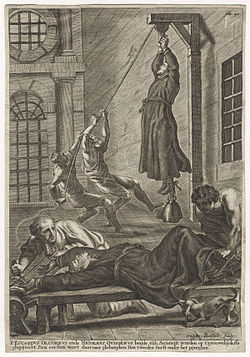 Two Jesuits suffered martyrdom on April 7, 1606 in connection with the Gunpowder Plot early in James I's reign--although they had no involvement with the Plot, the fact that they were companions and associates of Father Henry Garnet--and in fact, were captured with him after hiding for days in different hiding places within Hindlip Hall. Also captured that day was the designer and builder of those hiding places, Jesuit lay brother Nicholas Owen. The two lay brothers were in one hiding place and the two priests in another. The pursuivants could not find them--searching the house for days--but they finally had to leave their sanctuaries becauce of hunger and thirst. The illustration at the right shows Father Oldcorne and Owen enduring torture.
Two Jesuits suffered martyrdom on April 7, 1606 in connection with the Gunpowder Plot early in James I's reign--although they had no involvement with the Plot, the fact that they were companions and associates of Father Henry Garnet--and in fact, were captured with him after hiding for days in different hiding places within Hindlip Hall. Also captured that day was the designer and builder of those hiding places, Jesuit lay brother Nicholas Owen. The two lay brothers were in one hiding place and the two priests in another. The pursuivants could not find them--searching the house for days--but they finally had to leave their sanctuaries becauce of hunger and thirst. The illustration at the right shows Father Oldcorne and Owen enduring torture.Blessed Edward Oldcorne was a Jesuit priest, ordained in Rome, Italy, and received into the Society in 1587. Worked in the English mission in Worcestershire for 16 years. Father Edward developed throat cancer, but kept preaching through the pain. He made a pilgrimage to the shrine of Saint Winifred of Wales in Flintshire to seek a cure; his cancer healed, and he returned strong and healthy to his vocation.
Edward fell victim to the revenge following the Gunpowder Plot, a foolish conspiracy hatched by a small group of frustrated Catholic Englishmen to blow up the king and parliament. All it did was provide an excuse for renewed persecution of Catholics, especially Jesuits. Edward was arrested, falsely accused, and tortured on the rack for five days for information about the Plot. He was hung, drawn and quartered on April 7, 1607 with Blessed Ralph Ashley, SJ.
Blessed Ralph Ashley worked as a cook at Douai College. Entered the English College at Valladolid on 28 April 1590 where he became a Jesuit lay brother. Ill health forced him to leave college and return to England. Along the way he was captured by Dutch heretics; he stood up to them and explained their errors. Finally landed in England on 9 March 1598.
Servant and assistant to Blessed Edward Oldcorne. Arrested on 23 January 1606 at Hindlip House, near Worcester, England in connection with the Gunpowder Plot, and for the crime of helping a priest. Transferred to the Tower of London on 3 February 1606 along with Father Henry Garnet and Saint Nicholas Owen. Tortured for information on other Catholics and for the hiding places of priests. When they could get no information from him, he was transferred to Worcester, and condemned for his faith.
Of the four Jesuits captured at Hindlip Hall, three were recognized as martyrs by the Catholic Church and beatified or canonized. The torture and questioning of the two lay Jesuit brothers, St. Nicholas Owen and Blessed Ralph Ashley, was focused on discovering more hiding places like the ones the four Jesuits had been hiding in at Hindlip Hall. Owen died as a result of the torture meted out to him. Blessed Edward Oldcorne, because he was found with Garnet, was questioned about the plot. Father Henry Garnet has not been proclaimed a martyr by the Church, I presume because of questions about his involvement in the Gunpowder Plot. According to the old Catholic Encyclopedia (1909):
It is a matter of regret that we have as yet nothing like an authoritative pronouncement from Rome on the subject of Garnet's martyrdom. His name was indeed proposed with that of the other English Martyrs and Confessors in 1874, and his cause was then based upon the testimonies of Bellarmine and the older Catholic writers, which was the correct plea for the proof of Fama Martyrii, then to be demonstrated. But these ancient authorities are not acquainted with Garnet's actual confessions which were not known or published in their time. The consequence was that, as the discussion proceeded, their evidence was found to be inconclusive, and an open verdict was returned; thus his martyrdom was held to be neither proved nor disproved. This of course led to his cause being "put off" (dilatus) for further inquiry, which involves in Rome a delay of many years.
"A delay of many years" indeed.
Published on April 06, 2013 23:00
St. Henry Walpole, April 7, 1595
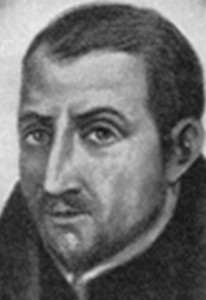 Another of the great Jesuit martyrs of the Elizabethan era, Henry Walpole was on his way to a legal career, which would have meant conformity and uniformity with the established Church of England. But he happened to attend the executions of St. Edmund Campion and his companions on December 1, 1581--and drops of the saint's blood fell on him. He abandoned the path to worldly success and left England. A poem, lamenting the death of one of the diamonds of England, is attributed to Walpole:
Another of the great Jesuit martyrs of the Elizabethan era, Henry Walpole was on his way to a legal career, which would have meant conformity and uniformity with the established Church of England. But he happened to attend the executions of St. Edmund Campion and his companions on December 1, 1581--and drops of the saint's blood fell on him. He abandoned the path to worldly success and left England. A poem, lamenting the death of one of the diamonds of England, is attributed to Walpole: Why do I use my paper, ink and pen?
Why do I use my paper, ink and pen,
And call my wits to counsel what to say?
Such memories were made for mortal men;
I speak of Saints whose names cannot decay.
An Angel’s trump were fitter for to sound.
Their glorious death if such on earth were found.
That store of such were once on earth pursued,
The histories of ancient times record,
Whose constancy great tyrants’ rage subdued.
Through patient death, professing Christ the Lord:
As his Apostles perfect witness bare,
With many more that blessed Martyrs were.
Whose patience rare and most courageous mind,
With fame renowned perpetual shall endure,
By whose examples we may rightly find,
Of holy life and death a pattern pure.
That we therefore their virtues may embrace
Pray we to Christ to guide us with his grace.
William Byrd set this poem to music, and you may hear a performance of it here.
According to this blog, after studying for the priesthood on the Continent, becoming a Jesuit, and enduring imprisonment while serving English Catholics in the Spanish Netherlands, Walpole returned to England on December 4, 1593 and was betrayed and captured almost immediately.
One night of freedom in England was followed by 16 months of imprisonment. Walpole admitted during his first interrogation that he was a Jesuit and had come to England to convert people. He was transferred to York Castle for three months, and was permitted to leave the prison to discuss theology with Protestant visitors. Then he was transferred to the Tower of London at the end of February, 1594, so that the notorious priest-torturer Richard Topcliffe could wrest information from him.
Walpole was tortured brutally on the rack and was suspended by his wrists for hours, but Topcliffe stretched the tortures out over the course of a year to prevent an accidental death. Walpole endured torture 14 different times before being returned in 1595 to York to stand trial under the law that made it high treason for an Englishman simply to return home after receiving Holy Orders abroad. The man who had once aspired to be a lawyer defended himself ably, pointing out that the law only applied to priests who had not given themselves up to officials within three days of arrival. He himself had been arrested less than a day after landing in England, so he had not violated that law. The judges responded by demanding that he take the Oath of Supremacy, acknowledging the queen's complete authority in religion. He refused to do so and was convicted of high treason.
On April 7, Walpole was dragged out of York to be executed along with another priest who was killed first. Then the Jesuit climbed the ladder to the gallows and asked the onlookers to pray with him. After he finished the Our Father but before he could say the Hail Mary, the executioner pushed him away from the ladder; then he was taken down and dismembered. The Jesuits in England lost a promising young priest whom they had hoped would take the place of Father Southwell; they received another example of fidelity and courage.
The priest who died with St. Henry Walpole was Alexander Rawlins:
Alexander was born in Worcestershire, England, where he was jailed twice for his fervent Catholicism. In 1589 he went to the English seminary in Reims and was ordained there in 1590. Returning to England the following year (with another future martyr and saint, Father Edmund Gennings), Alexander was arrested. He was condemned to death and on April 7, 1595, and along with Henry Walpole was hanged, drawn, and quartered in York, England. He was beatified in 1929.
Saint Henry Walpole and Blessed Alexander Rawlins, pray for us.
Published on April 06, 2013 22:30
April 3, 2013
Happy Octave of Easter! with John Mason Neale
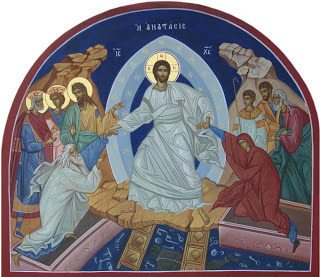
Just like Christmas, Easter is not just a day--it is a season of the Church's Liturgical Year. There are forty days between Easter and the Ascension and ten more until Pentecost. Liturgically, each day in the Octave of Easter is Easter Sunday, and so the hymnology of the Easter Season warrants some posts. And just as I did last Christmas, I'll focus on John Mason Neale's hymns and translations. He translated this hymn from the Greek by Saint John of Damascus, the great defender of Icons:
The day of resurrection! Earth, tell it out abroad;
The Passover of gladness, the Passover of God.
From death to life eternal, from earth unto the sky,
Our Christ hath brought us over, with hymns of victory.
Our hearts be pure from evil, that we may see aright
The Lord in rays eternal of resurrection light;
And listening to His accents, may hear, so calm and plain,
His own “All hail!” and, hearing, may raise the victor strain.
Now let the heavens be joyful! Let earth the song begin!
Let the round world keep triumph, and all that is therein!
Let all things seen and unseen their notes in gladness blend,
For Christ the Lord hath risen, our joy that hath no end.
Published on April 03, 2013 22:30



